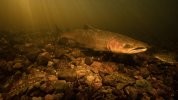Thanks BN for your photos. Admitting that it is difficult to accurately count lice from a photo - but in general - it appears that these fish are reasonably free of lice burdens - and importantly - the motile, adult phases. I am unsure whether those pics represent an average or expected lice loads across time and space. The time of year can be important, as well as history of lice treatments - as well as local oceanographic/estuarine conditions.
The lice limit for treatment on cultured fish is dictated within the Conditions of Licence (CoLs), and in the last few years - the industry has responded with numerous well boat treatments of H2O2 instead of Slice - which has become ineffective due to a build up of resistance by the lice.
IF today the treatments have now facilitated a decrease in lice loads on wild, outmigrating smolts - then that is to me cause for acknowledgement of success in regulating the industry. I am pleased we are past the denials by industry pundits that the open net-pen industry operations affect the health and viability of adjacent wild stocks - that precluded effective lice treatment in the past.
And to add to GFs post - in commercial fisheries Conditions of Licence - 3rd party validators are common, as other other checks and balances (hailing-out, etc.) - that are missing from the finfish aquaculture CoLs.
I think dependable, unbiased monitoring and enforcement is always necessary in everything fisheries - as is independent research - including research on fish disease outbreaks that is still hidden and protected by DFO/CFIA.
The lice limit for treatment on cultured fish is dictated within the Conditions of Licence (CoLs), and in the last few years - the industry has responded with numerous well boat treatments of H2O2 instead of Slice - which has become ineffective due to a build up of resistance by the lice.
IF today the treatments have now facilitated a decrease in lice loads on wild, outmigrating smolts - then that is to me cause for acknowledgement of success in regulating the industry. I am pleased we are past the denials by industry pundits that the open net-pen industry operations affect the health and viability of adjacent wild stocks - that precluded effective lice treatment in the past.
And to add to GFs post - in commercial fisheries Conditions of Licence - 3rd party validators are common, as other other checks and balances (hailing-out, etc.) - that are missing from the finfish aquaculture CoLs.
I think dependable, unbiased monitoring and enforcement is always necessary in everything fisheries - as is independent research - including research on fish disease outbreaks that is still hidden and protected by DFO/CFIA.



